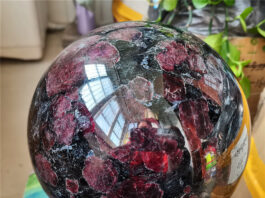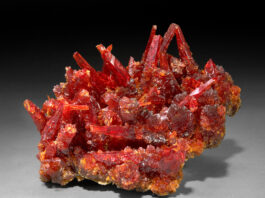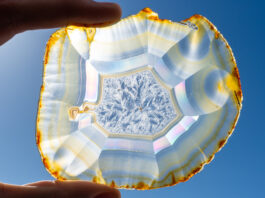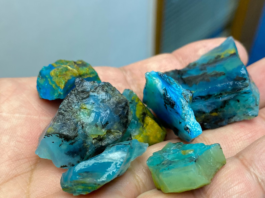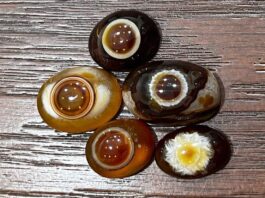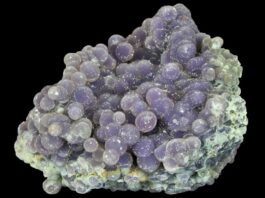Green obsidian is a captivating natural gemstone with a striking emerald hue, known for its intriguing origins and unique characteristics. This volcanic glass, which goes by various names such as “Green Sheen Obsidian” and “Green Rainbow Obsidian,” is a gemstone that has piqued the interest of gem enthusiasts and collectors worldwide. In this article, we’ll explore the origin, properties, and distinguishing features of green obsidian, shedding light on the captivating world of this mesmerizing gem. Whether you’re a gemstone connoisseur or simply curious about this exquisite stone, join us on a journey to discover the beauty and mystique of green obsidian.


Contents
Geological Formation of Green Obsidian
Green obsidian owes its existence to the fascinating world of volcanic activity and the specific geological conditions that shape this extraordinary gemstone. Here, we delve into the geological formation of green obsidian, elucidating the volcanic processes and factors that contribute to its unique coloration.
Volcanic Origins:
Green obsidian, like other types of obsidian, originates from volcanic eruptions. Obsidian is essentially a natural glass formed when molten lava cools rapidly, solidifying into a glass-like substance without the crystalline structure found in most minerals. This rapid cooling occurs when lava is ejected from a volcano and exposed to the relatively cooler air or water, causing it to solidify quickly.

Composition:
Obsidian is primarily composed of silica (silicon dioxide), similar to quartz, but it lacks a crystalline structure due to the fast cooling process. What makes green obsidian distinct is the presence of specific mineral inclusions or gas bubbles that create its vibrant green color.
Coloration Factors:
- Iron and Other Minerals: The green coloration of green obsidian is often attributed to the presence of iron and other minerals. Iron impurities, in particular, are known to impart a green hue to volcanic glass. The exact shade of green can vary depending on the concentration and type of minerals present.
- Sheen Effect: Green obsidian often exhibits a mesmerizing sheen or iridescence, sometimes called “Green Sheen Obsidian” or “Green Rainbow Obsidian.” This sheen is a result of microscopic mineral or gas bubble inclusions within the glass. When light interacts with these inclusions, it can create a play of colors or shimmering effect, further enhancing the gem’s beauty.
Geological Conditions:
Green obsidian can be found in regions with a history of volcanic activity. The geological conditions conducive to its formation include:
- Presence of Volcanoes: The presence of active or dormant volcanoes is a primary requirement for the formation of green obsidian. These volcanoes must be capable of producing lava flows that can cool quickly to form obsidian.
- Lava Composition: The composition of the lava is critical. It should have a high silica content, which is typical of many volcanic eruptions, to result in the formation of obsidian.
- Rapid Cooling: The lava must cool rapidly to prevent the crystalline structure from developing. This rapid cooling can occur when the lava contacts air or water, such as when it flows into a river, lake, or the ocean.
- Mineral Inclusions: The specific minerals present in the volcanic environment influence the coloration and inclusions in green obsidian. Iron, for instance, is responsible for the green color, while other minerals contribute to the sheen effect.
In summary, green obsidian’s geological formation is a result of volcanic processes that involve the rapid cooling of lava rich in silica, combined with the presence of minerals like iron and unique inclusions. These geological conditions come together to produce the captivating green hue and distinctive sheen that make green obsidian a sought-after gemstone for both its aesthetic appeal and geological significance.
Physical Properties

Green obsidian possesses a range of physical properties that make it a visually captivating and distinctive gemstone. Understanding these characteristics is essential for both appreciating its beauty and working with it in various applications. Here are the key physical properties of green obsidian:
- Color:
- The most prominent and distinguishing feature of green obsidian is its vivid green color. The shade of green can vary from light to dark, and it may display various hues within the green spectrum.
- Some green obsidian specimens may exhibit a subtle or pronounced sheen or iridescence, which can create a shimmering or rainbow-like effect on the surface. This feature is responsible for names like “Green Sheen Obsidian” or “Green Rainbow Obsidian.”
- Transparency:
- Green obsidian is typically translucent to semi-translucent. It allows some light to pass through, and the degree of transparency can vary among different specimens.
- While most green obsidian is at least somewhat translucent, some pieces may be more opaque, depending on the specific mineral inclusions and the presence of gas bubbles within the glass.
- Texture:
- Green obsidian has a glassy or vitreous texture, similar to other types of obsidian. Its smooth and polished appearance, along with its natural luster, enhances its aesthetic appeal.
- It often exhibits a conchoidal fracture, meaning it breaks with curved, smooth surfaces that resemble the way glass shatters when it breaks.
- Luster:
- Green obsidian typically has a glassy or vitreous luster, which contributes to its attractive appearance. This luster gives the gemstone a shiny, reflective surface when cut and polished.
- Hardness:
- Green obsidian is relatively hard, with a Mohs hardness rating of approximately 5 to 5.5. While this is not as hard as some gemstones like diamonds, it is still durable enough for use in jewelry and decorative items.
- Its hardness means that it can be scratched by harder materials, so care should be taken to prevent abrasion with other gemstones or minerals.
- Fracture:
- Green obsidian exhibits a conchoidal fracture, which is characterized by smooth, curved surfaces when it breaks. This type of fracture is common in glassy materials like obsidian and creates sharp edges, which is why obsidian has historically been used for tools and cutting instruments.
In summary, green obsidian is renowned for its striking green color, ranging from light to dark shades, and often features a captivating sheen or iridescence. Its translucency, glassy texture, and vitreous luster contribute to its visual appeal, making it a popular choice for jewelry and decorative items. Its moderate hardness and unique fracture characteristics also make it an interesting material for lapidary work and crafting. Understanding these physical properties helps one appreciate the aesthetic and practical aspects of green obsidian.
Common Uses and Applications

Green obsidian, with its captivating appearance and unique properties, finds various practical uses in jewelry, decorative items, and alternative healing tools. Here are some common applications of green obsidian:
- Jewelry:
- Gemstone Jewelry: Green obsidian is a popular choice for gemstone jewelry. It is often cut and polished into cabochons, beads, pendants, and other jewelry components. Its vibrant green color and occasional sheen make it an attractive choice for earrings, necklaces, bracelets, and rings.
- Carvings and Sculptures: Artisans and jewelry designers may also use green obsidian for intricate carvings and sculptures, creating one-of-a-kind pieces with unique designs.
- Decorative Items:
- Home Decor: Green obsidian is used in decorative items such as figurines, paperweights, and tabletop ornaments. Its rich color and natural luster add a touch of elegance and mystique to interior decor.
- Display Pieces: Collectors often showcase green obsidian specimens in display cases or as part of their mineral and gemstone collections.
- Alternative Healing and Metaphysical Practices:
- Energy Work: Some individuals believe that green obsidian has metaphysical properties associated with emotional healing and balance. It is thought to resonate with the heart chakra, making it a popular choice for energy work, meditation, and chakra balancing.
- Protection and Grounding: Green obsidian is also believed to have protective qualities, helping to shield against negative energies and promote grounding and stability.
- Healing Tools: In alternative healing practices, green obsidian may be used as a healing tool, often placed on or near the body to help address emotional or energetic imbalances.
- Lapidary and Craftsmanship:
- Lapidary Work: Green obsidian is sometimes used by lapidaries and artisans to create custom pieces, including carvings, engravings, and inlays. Its relatively high hardness makes it suitable for crafting into various shapes and designs.
- Knapped Tools: Historically, obsidian, including green obsidian, has been used by indigenous cultures to create cutting tools, arrowheads, and blades due to its sharp edges and conchoidal fracture. While this use is less common today, it highlights the material’s unique properties.
- Collectibles:
- Mineral and Gemstone Collecting: Green obsidian is sought after by collectors who appreciate its beauty and rarity. It can be an appealing addition to a collection of minerals and gemstones.
It’s essential to note that the use of green obsidian in alternative healing practices is based on metaphysical and spiritual beliefs rather than scientific evidence. As with any gemstone or mineral used for these purposes, the effectiveness and outcomes can vary from person to person. Additionally, the quality and authenticity of green obsidian can impact its suitability for specific applications, so it’s crucial to source it from reputable dealers or artisans.
Differences between Green Obsidian and Other Types of Obsidian

Obsidian is a diverse group of volcanic glass, and different types of obsidian exhibit unique colors, patterns, and properties. Here, we’ll compare and contrast green obsidian with three other common types: black obsidian, rainbow obsidian, and snowflake obsidian.
Green Obsidian:
- Color: Green obsidian is characterized by its vibrant green color, often with a sheen or iridescence. This unique green hue is due to the presence of minerals like iron.
- Transparency: It is typically translucent to semi-translucent, allowing varying levels of light to pass through.
- Sheen/Iridescence: Green obsidian often displays a sheen or iridescence, creating a shimmering effect.
- Energy Associations: In metaphysical and alternative healing practices, green obsidian is often linked to emotional healing, balance, protection, and grounding.
Black Obsidian:
- Color: Black obsidian is dark and opaque, with a glossy, jet-black appearance. It is one of the most well-known types of obsidian.
- Transparency: It is usually entirely opaque, meaning no light passes through.
- Sheen/Iridescence: Black obsidian doesn’t typically exhibit sheen or iridescence.
- Energy Associations: In metaphysical practices, black obsidian is often associated with protection, grounding, and removing negative energy. It’s considered a powerful stone for spiritual work.
Rainbow Obsidian:
- Color: Rainbow obsidian has a black or dark brown base color, similar to black obsidian. What sets it apart is the presence of colorful, shimmering bands or circles within the glass, resembling a rainbow.
- Transparency: Like black obsidian, it is opaque, but it has the added feature of the rainbow effect.
- Sheen/Iridescence: The distinctive feature of rainbow obsidian is the rainbow sheen that appears on its surface when viewed under proper lighting.
- Energy Associations: It is considered a stone for emotional healing, balance, and insight, often associated with the release of emotional blockages.
Snowflake Obsidian:
- Color: Snowflake obsidian is predominantly black with white, snowflake-like splotches or patterns, which are caused by the presence of cristobalite crystals.
- Transparency: It is opaque, like black obsidian, with the added visual element of the white snowflake patterns.
- Sheen/Iridescence: Snowflake obsidian does not typically display sheen or iridescence.
- Energy Associations: In metaphysical practices, it’s linked to inner reflection, self-awareness, and balance. It’s considered a stone for transformation and personal growth.
In summary, green obsidian stands out with its vivid green color and the occasional presence of a sheen. Black obsidian is known for its deep black color and protective qualities. Rainbow obsidian features a fascinating rainbow-like sheen on a black base, while snowflake obsidian combines black with distinctive white patterns. Each type of obsidian has its unique characteristics, making them suitable for various purposes, from decorative items and jewelry to alternative healing and metaphysical practices. The choice among these obsidian varieties depends on one’s aesthetic preferences and the specific energy or properties they seek in a gemstone.
Where to Find Green Obsidian

Green obsidian, while less common than some other types of obsidian, can be found in specific geological regions with a history of volcanic activity. Here are a few geographical locations where green obsidian is commonly found:
- United States:
- Glass Buttes, Oregon: Glass Buttes is a well-known location for various types of obsidian, including green obsidian. This area in central Oregon is famous among rockhounds and gemstone enthusiasts, and it’s a popular destination for collecting obsidian specimens.
- Mexico:
- Pachuca, Hidalgo: The state of Hidalgo in Mexico is renowned for its green obsidian deposits. Pachuca and its surrounding areas are known for producing this unique variety of obsidian. It’s often extracted and used by local artisans for crafting jewelry and decorative items.
- New Zealand:
- Mayor Island: Mayor Island, located in the Bay of Plenty, New Zealand, is another notable location for green obsidian. The island is an ancient volcanic caldera, and green obsidian can be found along its beaches and in its rock formations.
- Other Localized Deposits:
- Green obsidian can be found in other regions with volcanic activity and suitable geological conditions. These deposits may not be as widely recognized as the above-mentioned locations, but they can yield green obsidian if explored by collectors and enthusiasts.
It’s important to note that the availability of green obsidian can vary, and not all volcanic regions with suitable conditions will produce this specific variety. Additionally, due to its somewhat limited occurrence, green obsidian may be less common in commercial markets compared to other types of obsidian, such as black obsidian.
Collectors and enthusiasts interested in acquiring green obsidian may visit these known locations, explore geological sites with volcanic history, or purchase specimens from reputable mineral and gemstone dealers. It’s also advisable to respect any local regulations or restrictions related to collecting obsidian or other minerals in these areas.
Collecting and Identifying Green Obsidian

1. Research Locations: Begin by researching known locations where green obsidian can be found, such as Glass Buttes in Oregon, USA, Pachuca in Mexico, and Mayor Island in New Zealand.
2. Permission and Regulations: If you plan to collect green obsidian from these locations, ensure that you have the necessary permissions and are aware of any regulations or restrictions related to rock and mineral collecting.
3. Safety: Collecting obsidian may require tools such as chisels, hammers, and safety goggles. It’s important to exercise caution to prevent injuries while extracting specimens.
4. Identification: Green obsidian can vary in color and sheen. It should exhibit a green coloration, and the presence of a sheen or iridescence is a distinguishing feature. Carefully observe its transparency, texture, and other physical characteristics.
5. Cleaning and Preparation: Once collected, gently clean the green obsidian specimens with water and a soft brush to remove any dirt or debris. Be mindful not to scratch the surface.
6. Display and Appreciation: Green obsidian can be appreciated in its natural state, as well as when cut and polished. You can use it for decorative purposes, create jewelry, or incorporate it into your mineral and gemstone collection.
Green Obsidian Myths and Legends:
Green obsidian may not have as many cultural myths or legends associated with it compared to some other gemstones, but there are metaphysical and healing beliefs related to this unique gemstone. In metaphysical practices, green obsidian is often associated with:
- Emotional Healing: It is believed to help individuals heal emotional wounds and traumas, promoting inner balance and personal growth.
- Protection: Green obsidian is considered a protective stone, helping to shield individuals from negative energies and unwanted influences.
- Grounding: Some people use green obsidian to enhance their connection with the Earth and establish a sense of grounding and stability.
- Heart Chakra: It is said to resonate with the heart chakra, making it a stone of love and compassion.
While these beliefs are not grounded in scientific evidence, they contribute to the cultural and spiritual significance of green obsidian for some individuals.
Scientific Research and Studies:
Scientific research on the geological and mineralogical aspects of green obsidian is limited compared to more common minerals. However, the following avenues of research can be explored:
- Geological Studies: Researchers may investigate the geological conditions and volcanic formations that give rise to green obsidian. This includes examining the mineral compositions and environmental factors that influence its color and sheen.
- Mineralogy: Detailed mineralogical studies can help identify the specific minerals responsible for the green coloration and iridescence of green obsidian.
- Metaphysical and Healing Properties: While scientific studies do not validate metaphysical claims, researchers may explore the cultural, historical, and psychological aspects of how green obsidian is perceived and used in healing practices.
- Artistic and Craftsmanship Potential: The use of green obsidian in lapidary work, jewelry making, and artistic creations can be studied for its unique properties and potential applications in these fields.
In summary, collecting and identifying green obsidian can be a rewarding hobby, and while it may not have a rich history of cultural myths and legends, it holds metaphysical significance for some. Scientific research on green obsidian remains relatively limited, but there is potential for further exploration into its geological origins, mineral composition, and various applications.

